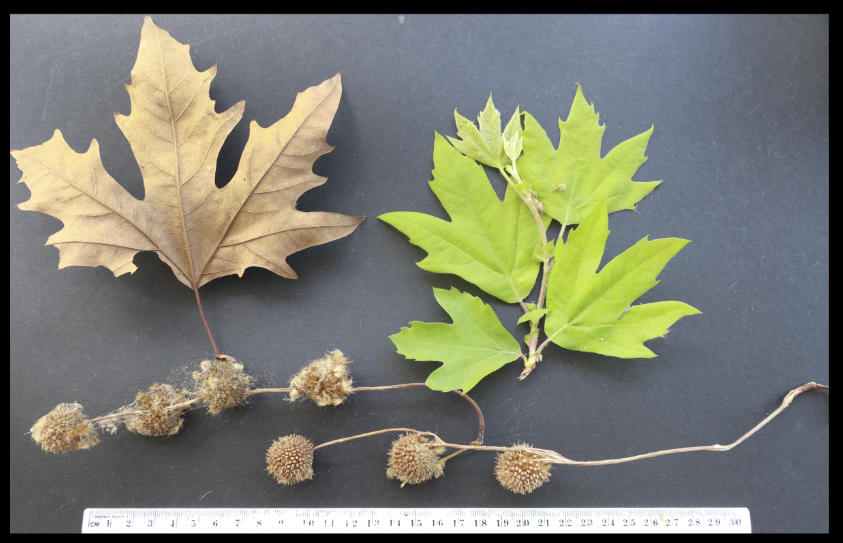Platanaceae.
Platanus is the only surviving genus in the Plane tree family so descriptions of the family and genus are similar.
The Platanus genus has 8 to 10 species native to the warmer areas of the northern hemisphere.
(The following description excludes P. kerrii which differs in being evergreen and having pinnate veins and axillary inflorescences.)
Mature trees, with one or several trunks are 10 to 20 (30 or more) m high.
The brownish bark frequently flakes off leaving a smooth surface mottled in cream and grey.
Alternately arranged leaves, on a petiole are spirally arranged.
The base of the petiole widens to cover the axillary stem bud which is covered in golden hairs.
Stipules have a basal sheath that surrounds the stem and a blade that can be very small and membanous to large, green and leaf-like with lobes, veins and teeth. They are usually deciduous.
The palmate (hand-like) leaf blade has 3 to 7 lobes with a smooth or toothed edge.
Young leaves have dense hairs that may remain on the lower surface or disappear on both.
The multicellular branched (dendritic) hairs can be stellate (all branches from the base) or a candelabrum with whorls of branches along the central axis.
A few only have very short terminal branches and may appear to be unbranched.
Hairs can be white, brownish or yellowish and some have glands.
Inflorescences are terminal with most on short side shoots.
Each consists of a pendulous stalk with 1 to 12 spherical heads or capitula that are directly attached (sessile) or on a very short peduncle.
Flowers are unisexual with the heads on each flowering stalk of a tree being either male or female.
There is a bract at the base of the head or its peduncle and a bracteole under each flower. Both have brown hairs that can be dense.
The densely packed flowers are only a few mms across and variable in their features.
All have 3 or 4 (7) or 6 – 8 (14) hairy sepals with free or fused bases.
Male or staminate flowers have 3 to 4 (7) tiny petals that may be hidden by hairs.
The 3 or 4 (7) fertile stamens have anthers that are on a very short or no filament.
Anthers have 2 pollen sacs that open laterally through longitudinal valves.
An appendage, from the connective tissue between the anther sacs forms a hood over them.
If there are any female parts they are minute pistillodes.
Female or pistillate flowers have sepals and no petals.
The superior ovary has (3) 5 to 8 (9) free carpels with 1 (2) ovules.
The stigma runs down the side of the style as 2 ridges with papillae.
There may be tiny infertile staminodes that are sometimes interpreted as the petals.
The fruiting head, up to 4 cm across has a central core with seeds from all the flowers attached making a multiple fruit.
Each flower produces a smooth or hairy club-shaped seed with a flat or pointed tip and sometimes with the style still attached.
The long hairs attached to the base of the seed continue to grow as it matures.
Each seed, with the pappus of hairs is commonly called an achene.
J.F.


